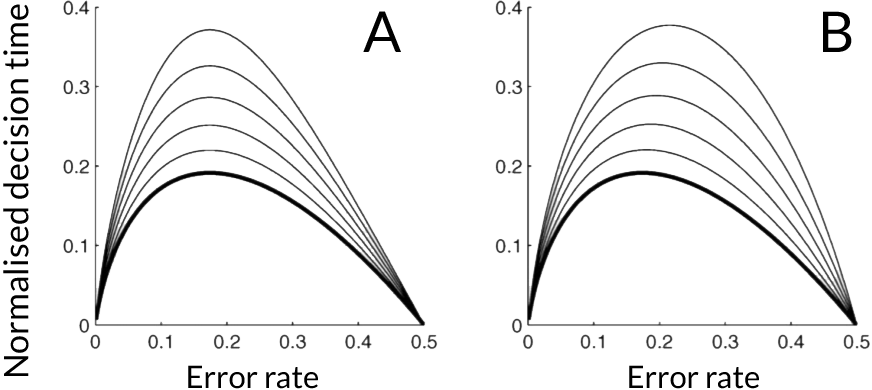Behaviour of humans in a two alternative choice task under conditions favouring either fast or accurate responses
This dataset comprises data and model parameters from two experiments.
Motion discrimination experiment
These data were mentioned in the paper 'The physics of optimal decision making', and described in detail in Section Experiment 1 of the paper 'Do humans select the speed-accuracy tradeoff maximizing reward rate?'.
This compressed file includes 20 files containg data for 20 participants of our experiment. The data are in Matlab format, so for example to see data from participant 5, you should load them first to Matlab by typing "load subject405". To see the list of variables in each file, type in Matlab "whos". Each file contains one numberical variable "money" decribing how much points the participant scored, and 7 variables which are vectors (one dimensional arrays) of a length equal to the number of trials the participant performed in the whole experiment. So each i-th trial is described by i-th entries of the 7 vectors. These vectors contain the following data:
- blocknum - number of block within the experiment, during which the trial was performed
- trialnum - number of trial within the block
- D - the delay between the response on this trial and onset of the next trial
- Dpen - additional penalty delay for making an error
- ST - binary vector describing the stimulus on the given trial, i.e. whether dots were moving leftwards or rightwards
- ER - binary vector describing whether participant made incorrect response on this trial
- RT - reaction time on the given trial [in seconds].
The parameters of the extended diffusion model estimated by DMAT toolbox are included. They are in the standard format of DMAT; for details see DMAT website.
The parameters of the pure diffusion model, estimated as described in the paper 'Do humans select the speed-accuracy tradeoff maximizing reward rate?' are also included.
This compressed file includes 20 files containing fits for 20 participants of our experiment. The data are in Matlab format, so for example to see fits from participant 5, you should load them first to Matlab by typing "load fits405". The parameters for each participant are described in the follownig variables:
- T0 - estimated non-decision fraction of reaction time [in seconds]
- par - vector of 6 parameters of pure diffusion model: drift A, noise c, 4 thresholds from 4 delay conditions.
Number of stars discrimination
These data were described in detail in Section Experiment 2 of the paper 'Do humans select the speed-accuracy tradeoff maximizing reward rate?'.
The data have very similar format as in the motion discrimination experiment, and the only difference is that each file contains an array Anum describing the difficulty of a trial: their entries are equal to 53 for difficult trials and 60 for easy.
The parameters of the pure diffusion model, estimated as described in the paper 'Do humans select the speed-accuracy tradeoff maximizing reward rate?' are included.
The files with parameters have very similar format as in the motion discrimination experiment, but arrays have an additional dimension corresponding to difficulty conditions:
- T0 - is now a vector of 2 numbers: T0(1) contains T0 for difficult conditions and T0(2) contains T0 for easy conditions
- par - array 2x6, in which the first row contains the parameters for difficult conditions (vector of 6 parameters of pure diffusion model: drift A, noise c, 4 thresholds from 4 delay conditions), and the second row contains the parameters for easy conditions.
We welcome researchers wishing to reuse our data to contact the creators of datasets. If you are unfamiliar with analysing the type of data we are sharing, have questions about the acquisition methodology, need additional help understanding a file format, or are interested in collaborating with us, please get in touch via email. Our current members have email addresses on our main site. The corresponding author of an associated publication, or the first or last creator of the dataset are likely to be able to assist, but in case of uncertainty on who to contact, email Ben Micklem, Research Support Manager at the MRC BNDU.

Attribution-ShareAlike 4.0 International (CC BY-SA 4.0) This is a human-readable summary of (and not a substitute for) the licence. You are free to: Share — copy and redistribute the material in any medium or format Adapt — remix, transform, and build upon the material for any purpose, even commercially. This licence is acceptable for Free Cultural Works. The licensor cannot revoke these freedoms as long as you follow the license terms. Under the following terms: Attribution — You must give appropriate credit, provide a link to the license, and indicate if changes were made. You may do so in any reasonable manner, but not in any way that suggests the licensor endorses you or your use. ShareAlike — If you remix, transform, or build upon the material, you must distribute your contributions under the same licence as the original. No additional restrictions — You may not apply legal terms or technological measures that legally restrict others from doing anything the licence permits.

